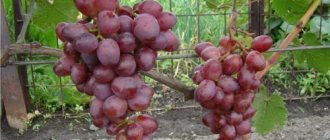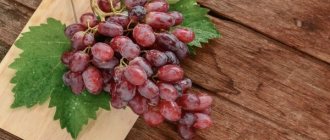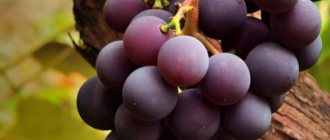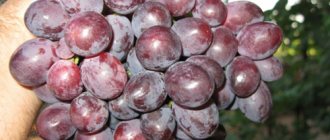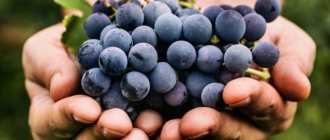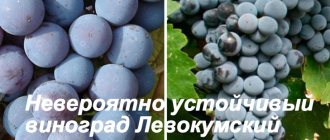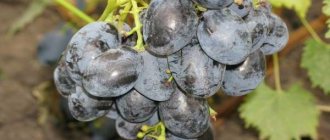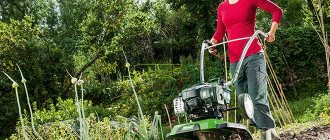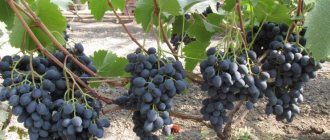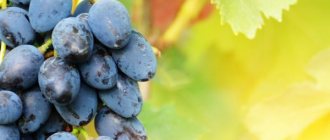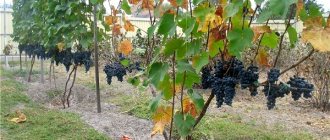All grape varieties are divided into two large groups: wine (or technical) and table (or dessert). It is table grapes that serve as a decoration for feasts; it is their clusters that lie in display cases and on counters: they are large, beautiful and very tasty. Today there are many varieties for table use, among them there are domestic grapes, and there are also foreign hybrids. Each of the table varieties has its own pros and cons, but all types have two important qualities in common: an attractive appearance and a unique taste.
Photos and descriptions of the most popular table grape varieties in Russia are given in this article. Here we talk about the classification of table species and provide recommendations for choosing a specific variety.
What is the difference between wine grapes and table grapes?
Grapes can be table and wine (technical). Unlike technical grapes, table grapes are used for preparing desserts and for fresh consumption. These are the grapes that are purchased to decorate the table for the holiday. It has large berries, most often in large clusters, and has a rich, sweet taste. Seeds may be present in small quantities, although sometimes they are not present at all.
At the same time, technical varieties are distinguished by high sugar content, oddly enough. Their berries are smaller but produce a more concentrated juice suitable for making wine.
What is the difference between wine grapes and table grapes?
Theory
According to their intended purpose, all grapes are divided into table and technical varieties. Table berries are large and sweet and are consumed fresh, while industrial berries are smaller and sour and are used for processing. But this does not mean that the technical group of varieties is worse, just in terms of the chemical composition they are completely different berries. The best grape varieties for wine are technical ones.
To make wine, you need sweet berries (15-30% sugar in juice) with relatively low acidity - 5.5-12 g/l. It is desirable that the juice yield be at the level of 65-85% of the weight of the berries.
If the problem of low sugar content can still be solved by adding sugar or fructose, then to reduce the acidity it is necessary to dilute the juice with water or neutralize the acid chemically, for example, with chalk, plaster or eggshells. In both cases, the quality of the drink will noticeably decrease.
In addition to varietal characteristics, the chemical composition of grape juice is influenced by climate: temperature during the growing season, relative air humidity, soil composition, number of sunny days, etc.
In general, it is easier to grow industrial grapes than table grapes. Most technical varieties are unpretentious in care: they can withstand sudden changes in weather, are frost-resistant, are more resistant to diseases, are less demanding on soil nutrition, and do without careful pruning. But for optimal sugar and acidity content, the berries must receive enough sun and moisture. It is also necessary to limit the yield by controlling the number of bunches - up to 2 kg of berries can be collected from one bush, otherwise the quality of the wine will deteriorate.
What are the differences between the best table grape varieties?
Also check out these articles
- The best varieties of cherries for the Moscow region
- Radish pests
- Peach variety Golden Moscow
- Fertilizers for flowers
New grape varieties are constantly being created. It is difficult to single out just a few of the best species among the wide variety. Still, professional winegrowers note that the best varieties of table grapes must have certain characteristics. What should the ideal table variety be?
- Suitable for growing in most climate zones.
- The seedlings quickly take root and actively develop.
- The bushes are frost-resistant and drought-resistant.
- The size of the bunches is medium. This is optimal for both selling and eating.
- The berries are large, symmetrical, dense, marketable.
- The peel is dense, but not rough, and is easy to chew.
- The color of the berries is uniform and rich.
- There are not many seeds and they are easily separated from the pulp.
- Since we are talking about a table variety, grapes from the best category should have an excellent taste.
- Bunches suitable for transportation.
- After picking, the berries can be stored for a long time.
As you can see, there are a lot of requirements and, unfortunately, it is difficult to find grapes that fully meet all these qualities. Most modern varieties only partially fit the description of the best grapes.
Early varieties of table grapes
Original
Large and vigorous growth with massive bushes and large berries. Productivity is slightly above average, with fruiting shoots making up about 75% of the total. The berries are an attractive pink or white-pink color, elongated, with sharp tips and dense skin. The original pleases not only with its fruits, but also with the neat appearance of the bushes: they are very similar to decorative ones. The variety is resistant to gray rot, downy mildew and powdery mildew. The grapes do not tolerate frost very well and are practically unsuitable for transportation due to the weak attachment of the berries to the bunch.
| Maturation period (days) | Bunch weight (g) | Shelf life (days) | Sugar content of pulp (%) | Tasting assessment | |
| 120-140 | 500-600 | 100-120 | 17-20 | 8.5 out of 10 | |
Early varieties of table grapes
Early varieties of table grapes are in great demand among winegrowers who grow the crop for sale. As a rule, they are characterized by high sugar content and tolerate transportation well.
- “Saffron Morning” is a large-fruited, early hybrid. Ripens in 100-110 days. The bush is vigorous, tall, and forms many stepsons. Flowers are bisexual. The clusters are cone-shaped or shapeless, not dense, often loose, weighing 0.7-1.5 kg. The berries are pink, large, elongated. Average weight is 18-20 g. The taste is pleasant, both sugar and acid are felt to a certain extent. The pulp is juicy, fleshy, the peel is medium in thickness, there are seeds, but not many of them. Sugar content 18% with acidity 6-7 g/l.
- “Zest” – large-fruited red grapes. The bushes develop quickly, the vine ripens well. The clusters grow beautifully, weighing 0.5-0.7 kg, not very dense. Women's flowers. The berries are red or burgundy, weighing 11 g on average. The pulp is dense, as is the peel. The taste is pleasant, without any frills. The variety is well pollinated, resistant to peas, frost-resistant down to -22°C, but the grapes need proper care. Sugar content 17% with acidity 4-5 g/l. May be affected by fungal diseases.
- “Transfiguration” is a hybrid grape that ripens in an average of 105 days. Vigorous, forms many stepsons. Flowers are bisexual. The clusters are cone-shaped or shapeless, most often loose, weighing 0.7-2 kg. The berries are elongated, large, can reach 5 cm in length and weigh about 20 g. The color is pink. The taste is delicate, sweet. Sugar content 18% with acidity 6-7 g/l.
- "Giovanni" is one of the best table hybrids, known throughout the world. Ripens in 100-105 days. The bushes develop quickly. The main difference is the carved leaves. Clusters of 0.5-1 kg, medium density. The berries are elongated, large, weighing about 12 g, almost burgundy in color. The pulp is elastic, the peel is dense. The taste is pleasant, sweet. The grapes are resistant to many diseases, drought and frost down to -25 degrees. If left on the vine for a long time, the berries dry out.
It is also worth including the varieties “Sensation”, “Descendant of Rizamat”, “Anniversary of Novocherkassk”, “Bazhena” here. Some of them are new, but all are universally loved by winegrowers for their excellent taste and rich aroma.
Medium table grape varieties
Best for different growing regions
For central Russia, varieties of medium ripening that are resistant to drought and frost are chosen. Baklanovsky grapes delight gardeners with large fruits and juicy, sweet pulp; they ripen in late June or early August. Kasparovsky grapes are immune to mildew, powdery mildew and gray rot, the berries are white, the taste is pleasant.
In the southern regions, late-ripening varieties are planted - Anthracite, Yalta, Taifi, Asma. The ripening period for such grapes is about 5 months, in some regions it reaches 6-6.5 months. Late grapes are resistant to high humidity and rarely get sick. The weight of the fruit is from 6 to 10 g, the color is black, white or pink - depending on the variety.
In the Urals and Siberia, early-ripening varieties that are resistant to viral and fungal diseases are grown. It is recommended to choose grapes that can withstand temperatures as low as -35°C. Suitable grapes for these regions are Lyubava, Preobrazhenie, Zorevoy.
Medium table grape varieties
We recommend reading our other articles
- Grape variety Bazhena
- Canned cucumbers
- Spring wheat
- Raspberry variety Orange miracle
Medium table grape varieties are used for sale, canning and fresh eating. They, like the early varieties, produce sweet berries that can be stored well.
- “Stars in Shock” is a unique variety of sultana. Ripens on average in 135 days. The clusters are large, weighing 0.8-1.2 kg, in the shape of a cone. There are no seeds. The taste is very good - this is one of the best table varieties! It stands out because the berries, after ripening, can hang on the branches for a long time, gaining sugar content, and do not spoil.
- "Baikonur" is a high-yielding variety. The bushes are vigorous. The berries grow up to 14 g, elongated, purple in color. The sugar content of the berries reaches 20%, the acidity is no more than 8 g/l. The taste is harmonious. The flesh is dense and crunches when bitten. The peel is dense, but edible. Suitable for long-term transportation.
- “Lady fingers” is one of the most famous table varieties. Flowers are bisexual. The clusters grow about 400 g each, but there are also larger ones. The berries are elongated, the peel is covered with a waxy coating. It is distinguished by the absence of seeds. The taste is sweet, the smell is pronounced and strong. Unfortunately, the variety does not tolerate drought well, has poor immunity and low frost resistance.
Bulgaria
Tall bushes of this variety are used not only to obtain a stable harvest, but also for decorative purposes. The berries are large, white with a light coating. The pulp is juicy, fleshy, the skin is thin and tender, not tough. The variety gives average yield, sometimes it can be “overloaded”, which is expressed in the appearance of weak and underdeveloped shoots. Therefore, the bush must be normalized and pruned. Resistance to diseases and severe frosts in Bulgaria is low, but the fruits can withstand long-term transportation.
| Maturation period (days) | Bunch weight (g) | Shelf life (days) | Sugar content of pulp (%) | Tasting assessment | |
| 110-120 | 400-800 | 60-80 | 17-20 | 8.2 out of 10 | |
Late varieties of table grapes
Late varieties of table grapes
Late table grape varieties ripen after all others. Some of them may ripen towards the end of autumn, but the berries need a lot of sun to gain sweetness and ripen, so these varieties are almost never grown in northern regions. In the middle zone they are sometimes found and yet they produce the richest harvest in warm, southern countries. Descriptions of late grape varieties are presented below.
- “Anyuta” is a hybrid grape that ripens in an average of 140 days. The bushes are distinguished by their high growth vigor. Flowers are bisexual. Clusters of 0.7-1.2 kg, pointed towards the tip, medium density. The berries are large, can grow up to 15 g, oval in shape, pink to dark pink in color. The taste is sweet, rich, nutmeg aroma. The peel is tough but edible. After ripening, grapes can be stored on the vine for a long time, do not pea, accumulate sugar well, and are recommended for sale.
- “Odessa Souvenir” is a productive variety that ripens in an average of 142 days. The bushes grow quickly and are very powerful. The clusters are cone-shaped, loose. The berries are large and elongated. The color of the peel is black, there is a noticeable coating. Each grape contains 3-4 seeds. The variety is resistant to many diseases characteristic of grapes, but has low frost resistance.
Table grapes are primarily grown for sale on an industrial scale, but they are often also planted simply for food on private lands. Such varieties are capricious and require high-quality care, but despite all their shortcomings, they do not lose popularity due to the taste of large, sweet berries.
conclusions
- Growing table grape varieties is an entire branch of farming , which, if properly organized, brings good profits.
- Table varieties are also an excellent choice for cottages and homesteads - a source of delicious vitamin-rich fruits for the home table.
- To organize a “grape conveyor” with an extended period of consumption, you need to plant several varieties that differ in ripening period.
- The varieties Laura, Cardinal, and Moldova are common in commercial viticulture . The varieties Aleshenkin, Laura, and Ruslan are well suited for amateur gardeners.
- Table grapes require careful care , proper agricultural technology, and protection from diseases. However, all the gardener’s worries are rewarded with a generous harvest of beautiful and tasty berries.
